#evolution of ethnic wear
Explore tagged Tumblr posts
Text
We have always had a particular place in our hearts for ethnic clothing. It's more than just clothing; it's a reflection of our cultural heritage, identity, and values. From traditional attire steeped in history to contemporary styles that blend tradition with modernity, ethnic wear has undergone a fascinating evolution. This journey from the past to the present showcases how ethnic wear has adapted to changing times while preserving its essence.
#celebrities#cultural heritage#cultural identity#designer ethnic sets for women#diversity of indian ethnic wear#eco-friendly fabrics#ethnic fashion history#ethnic sets for women#ethnic sets online#ethnic sets with pant#ethnic wear#ethnic wear collection#ethnic wear for women#ethnic wear for women online#ethnic wear ideas#ethnic wear kurta sets#ethnic wear online shopping websites#ethnic wear sets#evolution of ethnic wear#evolution of ethnic wear for ladies#fashion trends#fusion fashion#future of ethnic wear#gender-neutral fashion#handcrafted textiles#handloom#history of indian ethnic wear#inclusive fashion#indian ethnic sets#indian ethnic wear online
0 notes
Text
THE MODERN DESCENDANTS OF THE ZONAI
In my last post I explained how the game tells us that the Zonai came to Hyrule from somewhere else, and eventually disappeared, leaving just two Zonai behind.
There are only two possible explanations for why they disappeared.
1: They went back to where they came from. Pretty simple. 2: They died out. This is the possibility we'll be looking at.
There are two forms of extinction. Extinction as you probably know it, in which the species just dies out, and "Pseudoextinction" in which the species dies out, but in doing so has given rise to an entirely new species, either through evolution or mass breeding with a compatible species.
We know that Hylians and Zonai were sexually compatible, as Rauru; a Zonai, married Sonia; a Hylian, and started what would become the Hyrule royal family. Though never seen in game, they have surely reproduced by the time Zelda is sent back in time, as she is their descendant, both of their unique magical abilities, light and time, residing within her.
Another potential example of Zonai/non-zonai breeding is the nameless ancient hero, who appears to be Zonai, but his unique Zonai features are somewhat diminished, even lacking the Zonai's third eye entiely.

Oh yeah, Zonais have 3 eyes. Forgot to mention that. Its actually pretty important. The Zonai certainly think it is. The Zonai 3rd eye is very prominent in their artwork and fashion, and in armor and clothing made by Zonai to be worn by non-zonai, importance is given to this region of the head
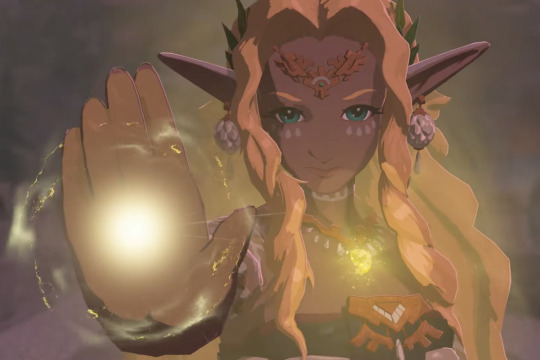

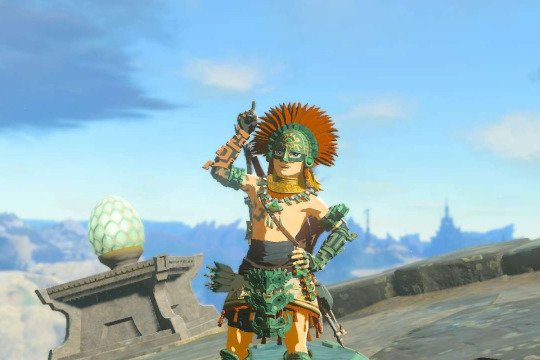
In fact, when Ganondorf obtains a sage's stone, he places it on his forehead, possibly to mark himself as an equal to the Zonai, a people who the land dwellers once saw as gods. But getting back to the subject at hand here... What if the Hyrulean royals and the nameless ancient hero aren't the only examples of Zonai/Hylian interbreeding?
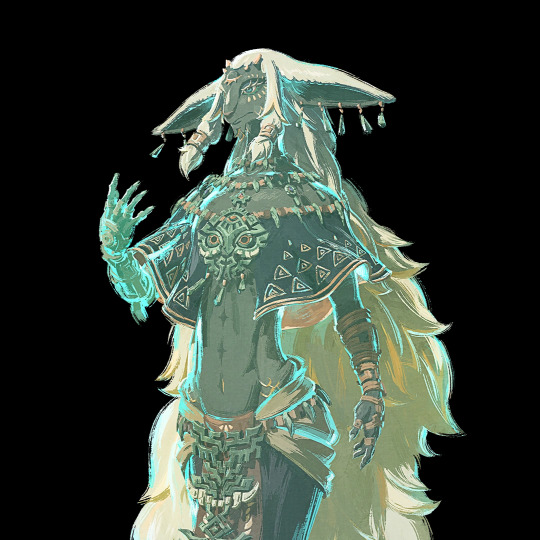
Here we see Rauru, a pure-blooded Zonai male His hair is naturally white, and he has a 3rd eye in the middle of his forehead. The eye is adorned with gold around the edges of the eyelid. When opened, and couple with the marking on the ridge of his nose, the 3rd eye takes on a very familiar appearance

Do you see it?
Here let me just...

Do you see it now?
I don't believe that the Zonai returned to their own world. I don't believe that all but two of them got sick and kicked all their buckets. I believe that the Zonai interbred with local Hylians to the point that the Zonai themselves, who likely already had a smaller population than the Hylians, vanished, and after further generations of breeding with more pure-blood Hylians, a new type of Hylian almost completely lacking Zonai features rose up in their place, co-existing with regular Hylians. I believe that group to be none other than...

The Sheikah. The importance placed on their bizarre eye symbol. The way their leaders wear that symbol in the center of their foreheads, representing a 3rd eye, which we now know is a literal trait of Zonai. Their penchant for advanced technology. The naturally white hair from birth, and the unusually long life spans despite being classified as Hylians*. I believe strongly that the Sheikah are the closest living descendants of the Zonai. This could also explain why the Sheikah are so dedicated to the Hyrulean royal family, because at its deepest roots, the royal family is as much Zonai as it is Hylian.
*In character logs, Sheikah are listed as "Hylian (Sheikah)" indicating that they're an ethnic group and not a separate race.
567 notes
·
View notes
Text
Quirk #13
Here is my thirteenth quirk idea! Feel free to use this in your fanfics (just give me credit if you directly got it from me) obviously I know however I’m not the only creative person in the world and that some people may have also had these ideas before me!



Quirk: Evolution
This quirk means that the user can evolve their body to new scenarios.
This entails:
- Their body will evolve with predicaments and quirks they are faced against.
- Adoptive Muscle Memory where after hit by a persons quirk her body will adapt to their fight style and usage of their quirk.
- Their quirk is good for both normal scenarios and hero scenarios. She'd be impartial to temperatures as her body will naturally aclimitize to it no matter what she's wearing. Or if she's being shot at her body may become liquid to have the bullets pass through safley.
- Can enhance and evolve others quirks (more of an awakening type vibe)
Weaknesses
- There are certain things that if the body is overloaded with trying to adapt to too much or cannot physically work out how to adapt to a quirk or scenario their quirk would be ineffective.
- Can cause effects to the body if poorly used. Skin hardens and causes marks etc.
- Overuse can lead to severe exhaust.
Strengths
- She'd be handy going in as decoy and working out what the potential quirks are as her body automatically will adapt to whatever is thrown at her and she'd be able to report back the quirk types there.
- She'd be good running in to risky rescue missions where people don't know how safe it is getting in and out, for example if theres a fire her skin will become heat resistant and she can get others out of there quicker.
Hero Name: Evolver
Zodiac: Libra
Ethnic Background: Japanese/ Welsh/ African
Height: 5ft 5
Weight: 127ibs
Style: Athlesuire Fashion



Physical Traits: She can morph her body at will as well as her body natural adapting so she often had black wings on her back.
Mannerisms: Doodles over their notes from class or paperwork when they get bored.
Favourite:
Food: Pork Bao Bun
Drink: Peach Iced Tea
Colour: Army Green
Weather: Tornado
Possession: She doesnt have one, she's very minimalist and doesn't like clutter of any kind.
Morning Routine:
She is a gym bunny so she wakes up and goes straight to the gym, has a whole workout befroe coming back for a shower. It doesn't take her long to get ready after a shower as she doesn't really do makeup or bother too hard with outfits.
Hobbies:
GYM she goes once a day if she can. She'd on occasion be known to do like goat or puppy yoga. Hiking! Anything active.
Special Skills:
She has very strong emotional intelligence consider what she has to deal with on a daily basis due to the nature of her quirk.
Pet Peeves:
She hates when lights are left on in a room because her mum once told her she'd melt the icecaps and kill polar bears of she left them on for too long.
Bad At:
Leadership, she's never been one to lead a group as she's used to be told what to do and where to go and thats easier for her.
Biggest Fear:
Chameleons (someone said her quirk was like one and she's been terrified eversince).
Greatest Flaw:
Her lack of foreward thinking and independence.
Goals:
To make lots of money as a hero to help her family.
Who I see them with:
Guys - TODOROKI, Crimson Riot
Girls - REIKO YANAGI, Pixie-Bob
#mha izuku#mha imagines#mha oc#mha#mha x y/n#mha x reader#mha x gender neutral reader#mha x you#mha bakugou#bnha x y/n#bnha imagines#bnha fanfiction#bnha x fem!reader#bnha x you#bnha x reader#bnha bakugou#my hero academia oc#mha quirk idea#mha quirks#my hero academia quirks#my hero academia x gender neutral reader#my hero academia x female reader#my hero academia x you#my hero academia x reader#my hero academia
8 notes
·
View notes
Text

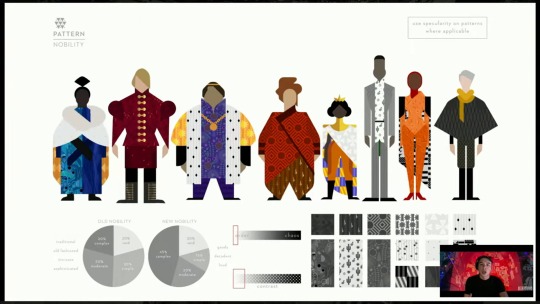




Maybe this was in the online digital Nimona artbook before it went offline, but I didn't pay attention to the costume design rules for all the people in the Kingdom, until this video "Visual Storytelling: The Production Design of 'Nimona'" by Gnomon (from which I screencapped all these pics).
It's interesting to consider how these clothing design rules symbolized Ballister's and Ambrosius's positions in society, but also might have reflected bits of their personalities.

"So we first approached it by a very anthropological approach, where we sat down and said, "if this world was to actually evolve in a closed setting, behind these walls, from the medieval, in this kind of fear-based world, how would society evolve from the medieval rules? And how would that work?" So we researched the medieval rules and found that there was the distinction between, you know, nobility and citizenry, and then non-citizens. And so that was a good place to start for us, to say of "How do we organize this massive pool and system of crowd characters? but in a---in a getable way, that also relates to our story and expresses this world that we're doing?""
The Institute:

Nobility:

"So we broke we broke it down into contemporary, um, a contemporary ideology, where our main---our nobility was much more based on, um you know, haute couture rules, where we were---they were simple. They were bold. They were evolution of the kind of royal colors and sumptuary laws that the medieval had, but in a modern, in a modern take."
Citizens:
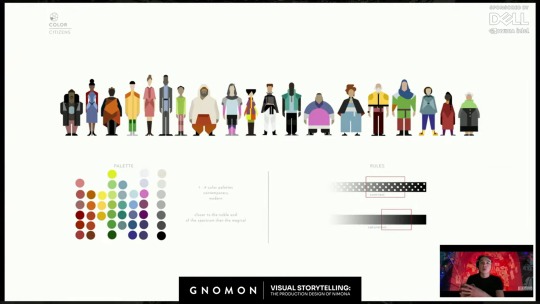
"Same with the citizens, where we leaned more into broader scope, where we needed to have the ability to have business wear, and athleisure, and, um you know, the color palettes that would be associated. …The range of body types that you would need, and…the range of races and ethnicities."
The Magicals:

Interesting thing about The Magicals, is this note "NO blue or neutral grey (due to the Institute's persecution, magicals have refused to wear Institute colors)."

Ballister's regular clothes seem to be the same color palette as The Magicals. Given the order of these slides, The Magicals seem to be the lowest rank in the Kingdom's society. Previous concept art showed that the Nimona 2023 movie originally would have portrayed a secret society of people with magical powers like Nimona. I assume these costume design rules were for them, though they got cut from the final movie. It seems appropriate that though Ballister has no magical powers, he is dressed in the colors of the Kingdom's lowest societal rank. But as anyone who has drawn him has noticed, the pendant on his shirt is blue. The one color which The Magicals do not wear, because it is the color of The Institute. Ballister is a commoner trying to become a Knight of the Institute, so it makes sense for him. And though Ballister's clothes could maybe be considered shades of gray (as per The Institute), they have the same dark values of The Magicals and are actually more of the "earthy" tones, noted in The Magicals' palettes. Ballister does not wear the light, almost silver, grays of The Institute. But he does wear a blue pendant. And though his pants have a thin golden stripe running down the sides, which is another color emblematic of The Institute, on second look, it is less gold, and more of a light tan, another earthy color. Almost makes me think that after the end of the movie, maybe he should change his blue pendant to purple, since these design instructions for The Magicals also note "One subtle purple item on each magical as a symbol of resistance and solidarity". (It explains the shade of purple in Nimona's skirt.)

Interesting to look at Ambrosius's outfit, while considering these design instructions. Ambrosius does not wear the "bold" colors or high amount of patterns prescribed for Nobility. Instead, he wears white and a dark shade of blue, with mostly solid, non-patterned clothes, as prescribed for The Institute. He is their symbol, through and through. Except for one point: his hoodie's secondary color of tan. Not only is tan an earthy tone, like The Magicals, the lowest societal rank in the Kingdom, but is takes up a noticeable amount of space in his outfit. It is almost like his one little piece of rebellion against his birth position and the expectations of society for him to represent The Institute and Nobility. It may be his one expression of who he is as a person, rather than the expectations placed onto him. It's kind of interesting that they let him get away with that. Maybe he had to fight for it. Maybe it makes him feel closer to Bal. Maybe he likes the distance it puts between him and the Institute. Maybe he didn't get brave enough to start wearing such colors until after he met Bal. (Now I'm getting into headcanon territory.)
Medievals:
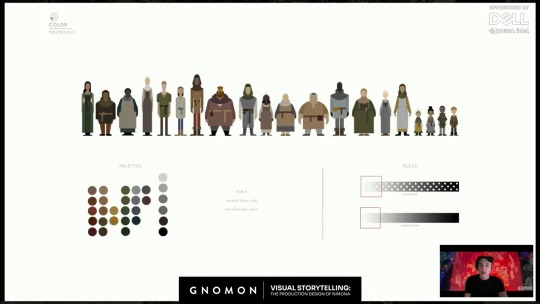
This was explained as the costume design instructions for the flashback characters from 1,000 years ago.
#drawing reference#costume design#nimona 2023#official art#headcanons#character analysis#ballister boldheart#ambrosius goldenloin#pinkfluidnf#ambrbalnf#color schemes#color palettes#patterns#fabric patterns#food for thought#nimona2023
25 notes
·
View notes
Text
St Patrick's Day Embrace the Irish Spirit

St. Patrick's Day, observed annually on March 17th, is a vibrant and globally celebrated cultural and religious holiday. Originally a feast day commemorating Saint Patrick, the patron saint of Ireland, it has evolved into a worldwide celebration of Irish culture, heritage, and spirit. This day is a time for people from all walks of life to embrace the "wearin' o' the green" and join in the celebrations, which include everything from pub gatherings to colorful parades, traditional Irish music, and the wearing of green and shamrocks. At The Festival Sale, we revel in the joy and unity that festivals bring, and we invite you to explore the rich history and lively traditions of this day.
Who Was Saint Patrick?
Saint Patrick, the holiday's namesake, was a 5th-century Romano-British Christian missionary and bishop in Ireland. While the exact details of his life are subject to some debate and legend, historical accounts and his writings, such as the Confessio, provide valuable insights.
Born in Roman Britain, likely in the late 4th century, Patrick was kidnapped by Irish raiders and brought to Ireland as a slave. In his incarceration, he found comfort in Christianity. He finally made his way back to Britain after six years. A vision later on, nevertheless, called him to return to Ireland and preach Christianity.
Patrick's missionary work in Ireland was remarkably successful. He traveled extensively, preaching, baptizing, and establishing churches and monasteries. He is recognized as instrumental in the Irish people's conversion to Christianity. Legend also attributes to him the use of the shamrock, a three-leafed clover, to explain the Holy Trinity (Father, Son, and Holy Spirit) to the Irish.
Saint Patrick died on March 17th, and this date has been observed as his feast day for centuries. Over time, the religious observance evolved into a broader celebration of Irish identity and culture.
The Evolution of St. Patrick's Day Celebrations:
Originally celebrated as a Catholic feast day, St. Patrick's Day has progressively evolved into a more secular celebration of Irish ancestry in Ireland and elsewhere.
Early Observances in Ireland: Early celebrations in Ireland were primarily religious, focusing on church services and honoring Saint Patrick.
The Irish Diaspora and Global Celebrations: The large-scale Irish emigration, particularly in the 18th and 19th centuries, played a significant role in spreading these day celebrations globally. Irish immigrants carried their traditions to countries like the United States, Canada, Australia, and beyond.
Parades and Public Festivities: In many of these new homelands, this day evolved to include public parades, often organized by Irish fraternal organizations and community groups. This parade evolved into a display of Irish pride and cultural identity. New York City hosted the first St. Patrick's Day parade in American history in 1762.
The "Wearin' o' the Green": Green became strongly associated with this day and Ireland. This association has roots in the green landscape of Ireland and the shamrock. Wearing green on this day is a widespread tradition.
Secularization and Broader Participation: Over time, this day has become increasingly secularized, with people of all ethnic backgrounds joining the festivities. It's a day to celebrate Irish culture, enjoy music and dance, and partake in the convivial atmosphere.
Key Traditions of St. Patrick's Day:
St. Patrick's Day is rich with traditions that are observed in various ways around the world:
Wearing Green: This is arguably the most common custom. To demonstrate their Irish pride and to prevent being mocked for not wearing green, people dress in green, accessorize with green, and even color their hair green.
The Shamrock: A well-known symbol of the day, the shamrock is said to have been used by Saint Patrick to preach about the Holy Trinity. Shamrock-themed décor is common, and some wear shamrock pins.
Parades: This day, parades are a major highlight in many cities worldwide. These parades feature marching bands, floats decorated in green, Irish cultural organizations, and often local dignitaries.
Irish Music and Dance: Traditional Irish music, with its lively reels and jigs, and Irish step dancing are integral parts of these day celebrations in pubs, cultural centers, and at public events.
Irish Drinks and Foods: The celebration of St. Patrick's Day often involves indulging in traditional Irish foods and beverages, with favorites like soda bread, Irish stew, and corned beef and cabbage being widely enjoyed. Irish beverages, particularly Guinness, are also a common part of the celebrations for many adults.
"Pinching" for Not Wearing Green: On this day, it's an amusing custom, particularly in the US, to pinch those who aren't wearing green.
"Kiss Me, I'm Irish" Slogans: Humorous slogans and merchandise featuring "Kiss Me, I'm Irish" are popular and contribute to the lighthearted atmosphere of the day.
River Dyeing: In Chicago, a unique tradition involves dyeing the Chicago River green for this day, a spectacle that draws large crowds.
St. Patrick's Day Around the World:
The celebration of St. Patrick's Day extends far beyond Ireland:
United States: The US has some of the largest and most elaborate celebrations on this day outside of Ireland, with major parades in cities like New York, Boston, Chicago, and Philadelphia.
Canada: Several cities with large Irish populations, including Toronto and Montreal, host St. Patrick's Day parades and celebrations.
Australia: This day is celebrated across Australia with parades, Irish music festivals, and green-themed events.
The United Kingdom: Irish populated cities around the UK celebrate and parade, in addition to Northern Ireland.
Ireland: Celebrations in Ireland have become increasingly vibrant in recent decades, with Dublin hosting a major multi-day festival featuring parades, concerts, and cultural events.
Other Countries: This day is also celebrated in various forms in countries worldwide, often organized by Irish expatriate communities and those who appreciate Irish culture.
The Festival Sale and the Joy of St. Patrick's Day:
At The Festival Sale, we embrace the spirit of joy, community, and cultural appreciation that embodies St. Patrick's Day. While we may not offer leprechaun costumes or pots of gold, we celebrate the desire to partake in the festive atmosphere and connect with the rich traditions of this global holiday.
Celebrating St. Patrick's Day:
There are several ways to take part in these day celebrations, regardless of whether you're of Irish descent or just like a good party:
Wear Green: To participate in the visual celebration, dress in your favorite green outfit.
Attend a Parade: Check local listings for these day parades in your area.
Enjoy Irish Music: Look for bars or events that include traditional Irish music and dancing.
Try Irish Food and Drink: Sample some classic Irish dishes and beverages.
Learn About Irish Culture: Take the opportunity to learn more about Irish history, literature, and traditions.
Join a Local Celebration: Many communities host this day's festivals and events.
Host a Green-Themed Gathering: Invite friends and family to celebrate with Irish-inspired decorations and food.
St. Patrick's Day is a testament to the enduring legacy of Saint Patrick and the vibrant spirit of Irish culture. It's a day that brings people together in honor of heritage, community, and the simple joy of "bein' green" for a day.
2 notes
·
View notes
Text
Joy-Ann Reid at Joy's House:
Marco Rubio has been many things. He’s been a rising star in Florida politics; Jeb Bush’s perceived heir apparent, to whom the former Republican governor and scion of the Bush dynasty literally handed a golden scepter as Rubio ascended to the speakership of the Florida House — becoming the first Cuban-American to do so. He’s been a rising national media star, who many of my fellow political journalists couldn’t stop gushing over from the moment of his 2010 U.S. Senate run, to the point where it wasn’t just a Republican diss: mainstream media repeatedly designated Rubio as the Republican’s Latin Obama: the literal Savior of the Grand Old Party. His immigrant background! His youthful Latin looks! His HAIR!!! For those who’ve covered him for years, he’s been the ultimate shape-shifter: switching religions (from Catholic to Mormon, back to Catholic and then to evangelical Christian, seemingly depending on the political utility… and switching political religions too. Rubio started life as a traditional Bush-Reagan Republican but somehow morphed into a “tea party” U.S. Senate candidate in 2010, when that designation became politically convenient with the rabidly Obama-hating Republican base. But Rubio was a Reaganite hiding in plain site.
[...] During his 2016 presidential bid, he tried to trip of Donald Trump’s first romp to the White House by trying penis size humor in response to Trump mocking him as “Lil’ Marco.” Sadly, it just made him look even “Liller” (although Trump did feel obligated to defend his allegedly tiny endowment.) At least Trump didn’t imply that Rubio’s wife, who is a former Miami Dolphins cheerleader, is ugly, like he did to Ted Cruz’s missus — after which Cruz, following a brief complaint, also sidled up to The Donald and meekly handed over his manhood. Like “Lyin’ Ted,” Lil Marco has gone on to become one of Trump’s most solicitous defenders, both during his first administration and now his second. So it should come as no one’s surprise that he has cast aside whatever is left of his dignity along with all remnants of his past positions supporting USAID and foreign aid in general as Trump’s obsequious secretary of state, along with his longtime loathing of the Kremlin and support for Ukraine’s freedom fight against Putin’s Russia, to bend the knee to Trump’s Putin adoration and hatred of any country Vlad wants to drag back into a Soviet Union. Not to mention getting on board with the complete ethnic cleansing of Gaza so Trump can erect a ghoulish fantasy resort from Hell on top of all those graves and demolished schools, universities, homes, mosques and hospitals. And that brings us to what was one of the most humiliating moments in the nearly 500 year history of the United States, when Rubio joined other benighted members of his soulless party in gang-tackling Ukranian president Volodomyr Zelenskyy in the Oval, where Zelenskyy was nagged about not wearing a suit and tie, badgered by Trump and Peter Thiel’s employee J.D. Vance for not being grateful enough or agreeing to quietly hand over his country’s rare earth minerals to Trump like the ransom business owners who wanted to see the sunlight in the 1940s handed in an envelope to the goons for the local mob boss. It was a display emblematic of the awful reality we are living in where Trump and his administration are proudly showing in full of the world, who the president of the United States really works for. As one European leader put it: the free world is gonna need a new leader.
Former MSNBC host Joy-Ann Reid has a solid column on the political evolution of Marco Rubio’s journey from establishment Republican in the Bush mold to MAGA shill.
#Marco Rubio#Trump Administration II#2016 GOP#Donald Trump#Tea Party Movement#Tea Party#Joy Ann Reid
2 notes
·
View notes
Note
Since that anon brings out the topic about Greek Gods looking like Greek. I would like to share about my culture, well my ancestors culture. Their religion used to be Hindu-Buddhism which means they worshipped both Gods from those religion. Mind you we are neither Indian or Chinese, but at no point in time do my ancestors changes those Gods to look like them. The statues were kept the same, the Hindu Gods hold their original features, wear their cultural attire and carry their symbolism same as the Buddhist Gods. My ancestors just worship them as they were. The temples also follows the structure from the regions respectively.
We no longer follows the same religion but we still tells their mythology and lore in our local traditions and I never felt estranged at all if these Gods don't look like me or my people at present because at one point in history, they were worshipped by my ancestors and they assimilate that religion into their culture.
So how can my ancestors can worship Gods that don't even look like them, even respect the culture they come from, but modern people who only read mythology couldn't?
Every culture treats their deities differently. It is not a matter of "who can" and "who cannot". With the same logic then how can Europe embrace Christianity but Middle East cannot? Simple because that is how cultures work and it is all part of the worshipping process. Every culture has their own essences and their own history of evolution in their culture.
Greeks for once like I said before valued their culture too much even when they literally incorporate things from other cultures in their mythology or pantheon. Like I answered to the other ask, even when they literally added Egyptian gods to their pantheon they still depicted them like themselves. Even their names were changed to fit their own linguistic preferences. Not all cultures evolve the same and not all cultures have the same target points or goals.
So people in modern times randomly changing their appearance has nothing to do with Greek culture at least as ancient Greeks perceived it. You describe a process that lasted for centuries. I oppose a modern trend that has no cultural background at all in antiquity or almost not at all and it is purely based on the essence of "we do it because is our imagination". Valid arguement but culturally speaking is not what the ancient greeks did. By n large the Greeks incorporated elements from other cultures in their own but transformed them to fit their image and their standards.
But you also mention the religion of iconographic change. Who said that Greeks did not change iconography to their gods? But even those changes were done in the spectrum of their own image.
And again what you describe is something that occured to your culture naturally and the people who worshipped them chose to follow that path which of course happens. The Greeks by n large kept their own iconography based on their own ethnicity.
I believe there is a misunderstanding on the matter, similarly as to people who like inaccurate retellings say to me "I can enjoy them both so why can't you?" the same goes with here. Just because one culture did it doesn't mean all did and each culture has their own standards and their own evolving process.
I hope that answers your question
PS: Also that anon had also mentioned swaps in general including people. Not just gods and goddesses.
#katerinaaqu answers#greek mythology#representation#cultural evolution#cultures evolve differently and have different points
5 notes
·
View notes
Text

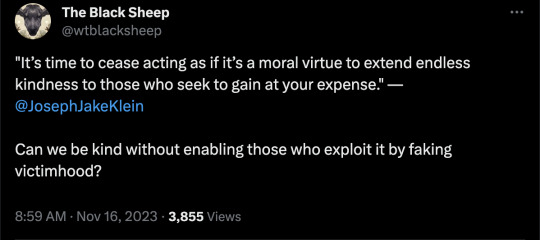

By: Joseph (Jake) Klein
Published: Nov 15, 2023
From top-to-bottom, society has conditioned us to think kindness is an unmitigated good. The golden rule to “do unto others as you would have others do unto you” is one of the most remembered lines of Jesus, but the lesson is near ubiquitous across both the world’s religions and secular moral philosophy. To be kind is one of the first lessons we teach our children. Our greatest works of fiction have focused on the heroism of kindness. Even our advertising frequently uses the morality of kindness to ingratiate us to brands.
But far from an unmitigated good, kindness has a dark side. The once virtuous cell of kindness has metastasized into a cancer. The evolution of kindness, manifested in the unparalleled cooperative ability of mankind, enabled the development of civilization.
In contemporary times, however, pathological kindness has become one of the greatest threats to bring about its destruction.
In the beginning, kindness was not a luxury, but a need. To escape the poverty and starvation inherent to the state of nature, humanity had no choice but to learn to be kind to each other in order to successfully cooperate and produce what they needed to survive. As the great economist Ludwig von Mises explained, “[w]e may call consciousness of kind, sense of community, or sense of belonging together the acknowledgment of the fact that all other human beings are potential collaborators in the struggle for survival because they are capable of recognizing the mutual benefits of cooperation, while the animals lack this faculty.”
“However,” Mises continues, kindness was not developed as a virtue purely in the abstract. “we must not forget that the primary facts that bring about such consciousness or such a sense are the two mentioned above. In a hypothetical world in which the division of labor would not increase productivity, there would not be any society. There would not be any sentiments of benevolence and good will.”
Kindness became a virtue precisely because it’s productive. But, in a world of abundance, kindness instead now often eats away at the resources of society. In a prosperous, advanced society where individuals have moved up Maslow’s Hierarchy of Needs, expressions of kindness towards those who cannot or will not help themselves has been able to develop as a dominant virtue.
Kindness towards those who cannot help themselves is indeed a virtue; anyone of us could fall into this situation through no fault of our own. But kindness towards those who will not help themselves, who seek to leech off of us rather than contribute to society’s progress, is where virtue slips into vice. Most dangerously, those who are successful at taking advantage of society’s kindness rarely admit they will not help themselves, but wear the mask of those who cannot.
When a scammer takes advantage of your kindness to profit at your expense, we all know they’re the bad guy. But when someone claims victimhood and takes advantage of you by passing laws and regulations, we’re supposed to call that the justice of democracy.
This is the politics of Leftism, from the Jacobins through classical Marxism and now wearing its more fashionable woke regalia. A class group or cultural group (including race, ethnicity, gender, sexual orientation, etc.) flips morality on its head by claiming itself as oppressed—those who cannot help themselves—and appeals to the vice of kindness to gain legal advantages over other groups and redistribute resources towards itself.
To be clear, not everyone on the Left is a manipulative leech. Numerically most will be manipulated hosts. But their manipulators fit a personality type known as the dark tetrad: narcissism, psychopathy, machiavellianism, and sadism. Amongst other traits, dark tetrad types tend to present with a sense of entitlement and a victim mentality. Studies have demonstrated a strong link between the dark tetrad personality and politically correct authoritarian behavior, which includes a belief in censorship of words and ideas deemed offensive by the authoritarian, that those who utter these words and ideas should be punished for it, and a belief that alleged perpetrators of crimes against a victim group should be treated as guilty before proving their innocence.
Distinguished evolutionary biologist Richard Dawkins brilliantly explains in the video below how evolution leads to the existence of such dark tetrad behavior. A world full of kind people is evolutionarily unstable as it creates an incentive to take advantage of the productive ability of the kind masses. But if those who live by leeching off of others become dominant in society then it’s just as evolutionarily unstable, as society collapses from its inability to produce. A society mostly full of kind people, but with a few leeches, can last for the long run.
youtube
In an era where victimhood culture is becoming dominant, we are moving into unstable space. It wouldn’t be the first time such an unstable arrangement had the opportunity to destroy a civilization—just look at the Soviet Union. While dark tetrad personalities only constitute about 7% of the international population, in the contemporary West the leech’s activism appears to have led to a far larger percentage of their hosts accepting their destructive ideas. These hosts are overrepresented amongst the world’s upper classes given that being higher on Maslow’s Hierarchy provides more of an opportunity to extend pathological kindness. Rob Henderson has famously labeled this phenomenon “luxury beliefs.”
So what do we do about this problem? You read it already: it’s time to stop being kind to people. Not everyone, obviously, kindness is usually a virtue and should be extended to everyone who wishes to cooperate to build our shared society in peace and productivity, and should also extend to the many well-intentioned hosts of bad ideas who know not what they do.
But when it comes to the leeches, it’s time to cease acting as if it’s a moral virtue to extend endless kindness to those who seek to gain at your expense. Feeding their victimhood and entitlement is what provides an incentive for them to continue; like training an animal, when the rewards cease the behavior will follow.
As the French economist Frédéric Bastiat put it, “[w]hen, then, does plunder stop? It stops when it becomes more painful and more dangerous than labor.”
Yes, many already express hostility and disgust towards the woke and mock them online (and sometimes in person), but how many speak of it with clarity as a moral virtue to do so? To make the leech’s hosts stop feeding them, they must understand that their overextended kindness is a moral evil.
At least one woman understood this: Ayn Rand. Rand spoke of the “virtue of selfishness,” pioneering clickbait tactics with an intentionally provocative phrase designed to grab people and force them to think, but that when explained becomes more agreeable than at first glance. “Selfishness” to Rand did not mean gaining at another’s expense, as the leeches (or “parasites," in her words) do, but acting in one’s long-term rational self-interest. That includes being kind to those who work cooperatively with us to make the world a better place, which is most people most of the time. But to be virtuously selfish, in Rand’s view, one must oppose altruism: self-sacrifice for another’s gain.
Unkindness towards those who deserve it needn’t and shouldn’t be a permanent attitude. Those willing to stop using victimhood as a weapon should be met with forgiveness. Perhaps they should even be treated with disproportionate kindness to encourage others to also give up their maladaptive beliefs. We want to reward people who stop their pathological behavior and join the cooperative harmony of human civilization. But until then, we must be brave. We must be willing to be seen as black sheep in order to fix society’s broken morality.
Don’t be kind to those who seek your destruction, and know and say loudly that you are right not to do it.
==
It's not a kindness to help people avoid living in reality. It's not kindness to lie in order to deprive grown adults of the opportunity to live in the real world.
We don't lie to the religious any more. We don't pretend to pray with them because they'd be offended otherwise. We don't say that their faith is reason enough to believe an obvious lie.
Stop letting people manipulate you into lying for their benefit.
#Jake Klein#Joseph Klein#The Black Sheep#be kind#weaponized empathy#empathy#kindness#religion is a mental illness#Youtube
15 notes
·
View notes
Text
------------------------------------------------------------------------------
Classification: There is a division of "us" v. "them," often carried out using stereotypes or excluding people perceived as different.
------------------------------------------------------------------------------



------------------------------------------------------------------------------
Dehumanization: Those who are perceived as "different" are treated with no form of compassion or personal dignity. Dominant groups will refer to affected groups as "animals," "inhuman," or "vermin."
------------------------------------------------------------------------------



------------------------------------------------------------------------------
Discrimination: The dominant group denies civil rights and even citizenship to identified groups.
------------------------------------------------------------------------------



------------------------------------------------------------------------------
Polarization: Propaganda begins to incite messages of hate or fear about those perceived as "different."
------------------------------------------------------------------------------




------------------------------------------------------------------------------
Symbolization: A visual manifestation of hatred, often forcing an "othered" group to wear or carry a marker to show they're "different."
------------------------------------------------------------------------------



------------------------------------------------------------------------------
Organization: Genocide is always planned. The perpetrators are trained and armed, often by the state or state actors. They begin to build up armies and stock weapons.
------------------------------------------------------------------------------




------------------------------------------------------------------------------
Preparation: Perpetrators plan the genocide. They will have organized, institutional plans to kill and will cloak it with euphemisms.
------------------------------------------------------------------------------


------------------------------------------------------------------------------
Persecution: Victims are singled out because of their ethnicity or religion, and death lists are drawn up. People are sometimes segregated into ghettos, deported or starved, and property is often expropriated. Massacres begin.
------------------------------------------------------------------------------





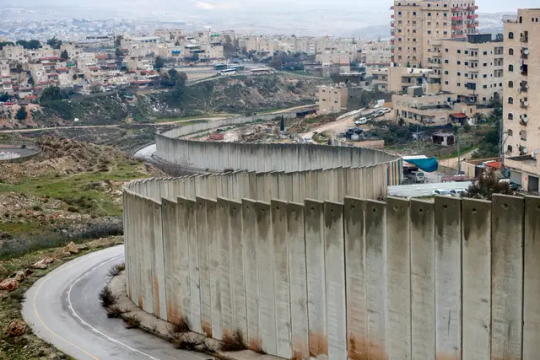


------------------------------------------------------------------------------
Extermination: The hate group murders its identified victims in a deliberate and systematic campaign of violence.
------------------------------------------------------------------------------
4 notes
·
View notes
Text
Artificial Jewellery: Your Ultimate Online Shopping Destination
In an era characterized by rapid digital transformation, the way we shop for jewelry has undergone a significant evolution. Gone are the days when you had to visit multiple stores, sift through countless options, and haggle over prices to find that perfect piece of jewelry. Today, the world of best artificial jewellery online has emerged as a game-changer, offering a vast array of stylish, affordable, and trendy options. Saheli Ethnic Indian Wear, a leading online shopping destination, has carved its niche as the ultimate hub for artificial jewelry.
In this comprehensive guide, we'll delve deep into the world of artificial jewelry, explore the offerings at Saheli Ethnic Indian Wear, and understand why it has become the go-to platform for jewelry enthusiasts.

The Rise of Artificial Jewelry
A Brief History of Artificial Jewelry
Artificial jewelry, also known as imitation or fashion jewelry, has a long and fascinating history that dates back centuries. The concept of replicating precious jewelry with less expensive materials has been a part of human culture for generations. Historically, artificial jewelry was made from materials like glass, enamel, and base metals to mimic the appearance of gold, silver, and gemstones. Over time, advancements in craftsmanship and technology have elevated artificial jewelry to a whole new level.
Why Choose Artificial Jewelry?
The allure of artificial jewelry lies in its versatility and affordability. Here are some compelling reasons why people are increasingly opting for artificial jewelry:
1. Affordability
Precious metals and gemstones come with hefty price tags. Artificial jewelry, on the other hand, offers the same aesthetic appeal at a fraction of the cost, making it accessible to a wider audience.
2. Trendy Designs
Artificial jewelry designers continuously innovate, staying on top of fashion trends. This means you can easily find pieces that reflect the latest styles and designs without breaking the bank.
3. Variety
Artificial jewelry comes in a staggering variety of designs, colors, and styles. Whether you're looking for traditional Indian pieces or contemporary designs, you'll find something that suits your taste.
4. Everyday Wear
Artificial jewelry is perfect for everyday wear. You can enjoy accessorizing your outfits without worrying about the risk of losing expensive pieces.
Saheli Ethnic Indian Wear - Your One-Stop Shop for Artificial Jewelry
In the realm of artificial jewelry, Saheli Ethnic Indian Wear has emerged as a trusted and go-to online destination. Let's take a closer look at why this platform has gained such popularity.
A Wide Range of Choices
Traditional Elegance
Saheli Ethnic Indian Wear offers a stunning collection of traditional artificial jewelry that perfectly complements Indian attire. From intricately designed Kundan sets to beautiful Meenakari pieces, you'll find the ideal accessories to complete your ethnic look.
Contemporary Chic
If you're more inclined toward contemporary fashion, Saheli Ethnic Indian Wear has you covered. Explore their extensive range of modern and trendy artificial jewelry that effortlessly enhances your Western or fusion ensembles.
Quality and Craftsmanship
Impeccable Craftsmanship
One of the hallmarks of Saheli Ethnic Indian Wear is its commitment to craftsmanship. Each piece of artificial jewelry is meticulously crafted by skilled artisans, ensuring that you receive jewelry that not only looks stunning but also lasts for a long time.
Premium Materials
Saheli Ethnic Indian Wear uses high-quality materials to create their artificial jewelry. From premium alloys to carefully selected stones and beads, the attention to detail is evident in every piece.
Affordability and Value
Competitive Pricing
At Saheli Ethnic Indian Wear, affordability is a priority. You can enjoy the luxury of wearing beautiful jewelry without burning a hole in your pocket. Their competitive pricing ensures that you get exceptional value for your money.
Discounts and Offers
Keep an eye out for regular discounts and special offers on Saheli Ethnic Indian Wear. They frequently run promotions that allow you to snag your favorite jewelry pieces at even more attractive prices.
Convenience and Trustworthiness
User-Friendly Website
Saheli Ethnic Indian Wear's website is designed with the user in mind. It's easy to navigate, ensuring a seamless shopping experience from browsing to checkout.
Customer Reviews
The platform boasts an impressive collection of positive customer reviews and testimonials, showcasing the satisfaction of countless shoppers who have found their perfect jewelry pieces at Saheli Ethnic Indian Wear.
The Saheli Experience: From Selection to Delivery
Finding Your Perfect Jewelry
Browsing through the extensive collection of Saheli Ethnic Indian Wear is a delightful experience. The website offers multiple filters and search options, making it simple to find the jewelry piece that resonates with your style.
Hassle-Free Checkout
Once you've selected your desired items, the checkout process is straightforward and secure. Saheli Ethnic Indian Wear offers multiple payment options, including credit/debit cards and online wallets, for your convenience.
Prompt Delivery
Saheli Ethnic Indian Wear prides itself on timely delivery. Your chosen jewelry pieces will reach your doorstep in pristine condition, ready to adorn your outfits.
Caring for Your Artificial Jewelry
Maintenance Tips
To ensure the longevity of your artificial jewelry, it's essential to care for it properly. Here are some maintenance tips:
1. Store Properly
Keep your jewelry in a cool, dry place away from direct sunlight to prevent discoloration.
2. Avoid Contact with Water
Remove your jewelry before swimming or bathing to prevent tarnishing.
3. Clean Gently
Clean your artificial jewelry with a soft, damp cloth to remove dust and sweat. Avoid harsh chemicals or abrasive materials.
4. Rotate Usage
Rotate your jewelry pieces to prevent excessive wear on any single item.
The Saheli Promise: Beyond Jewelry
At Saheli Ethnic Indian Wear, the commitment to customer satisfaction extends beyond the exquisite jewelry collection. Here are some additional reasons why Saheli has become the ultimate online shopping destination:
Customization Options
Personalized Touch
For those who desire a unique touch to their jewelry, Saheli Ethnic Indian Wear offers customization options. You can work with their team to create bespoke pieces that align perfectly with your style and preferences. Whether it's a custom engraving or a specific design, Saheli is dedicated to bringing your vision to life.
Customer Support
Expert Assistance
Navigating the world of jewelry can be overwhelming, especially if you're a first-time buyer. Saheli's customer support team is readily available to answer your queries, offer styling advice, and guide you through the selection process. Their friendly and knowledgeable staff ensures that your shopping experience is seamless and enjoyable.
Ethical Practices
Responsible Sourcing
Saheli Ethnic Indian Wear is committed to responsible and ethical sourcing of materials. They take steps to ensure that the materials used in their jewelry are ethically obtained, aligning with global sustainability and ethical standards.
Saheli Blog: A Treasure Trove of Fashion Insights
Fashion Trends and Tips
Saheli Ethnic Indian Wear's website features a blog section that is a treasure trove of fashion insights. Here, you can explore articles on the latest fashion trends, styling tips, and guides on how to accessorize effectively. Whether you're a fashion novice or a seasoned style icon, the Saheli blog has something for everyone.
Customer Stories and Reviews
The blog also showcases real customer stories and reviews, providing you with a glimpse into the experiences of individuals who have found their perfect jewelry at Saheli. Reading about others' journeys can help you make informed decisions and build trust in the brand.
Community Engagement
Supporting Artisans
Saheli Ethnic Indian Wear actively engages with and supports local artisans and craftsmen. By choosing Saheli, you contribute to the livelihoods of these talented individuals, fostering a sense of community and empowerment.
Exclusive Offers and Loyalty Rewards
Saheli VIP Club
For frequent shoppers, Saheli Ethnic Indian Wear offers a VIP Club membership. As a member, you gain access to exclusive discounts, early product launches, and special promotions. It's their way of expressing gratitude to their loyal customers.
Global Reach
International Shipping
Saheli Ethnic Indian Wear caters to a global audience. No matter where you are in the world, you can enjoy the beauty of Indian jewelry through their efficient international shipping services. Saheli brings the essence of Indian culture to your doorstep.
A Saheli for Every Occasion
Bridal Jewelry
For brides-to-be, Saheli Ethnic Indian Wear offers an enchanting collection of bridal jewelry. From statement pieces for the wedding day to elegant sets for pre-wedding functions, Saheli ensures that you shine on your special day.
Festive Collections
Indian festivals are known for their vibrant celebrations, and what's a celebration without stunning jewelry? Explore Saheli's festive collections to find the perfect adornments for occasions like Diwali, Eid, Navratri, and more.
Stay Updated with Saheli
Social Media Presence
Saheli Ethnic Indian Wear maintains an active presence on various social media platforms. Follow them on Instagram, Facebook, and Pinterest to stay updated on their latest arrivals, promotions, and styling ideas. Their social media channels are a source of inspiration for fashion enthusiasts.
Conclusion: Elevate Your Style with Saheli Ethnic Indian Wear
In the world of the best artificial jewelry, Saheli Ethnic Indian Wear stands out as a reliable, stylish, and affordable online shopping destination. Whether you're looking for traditional Indian jewelry or contemporary chic pieces, Saheli has something for everyone. With a commitment to quality, craftsmanship, and customer satisfaction, Saheli Ethnic Indian Wear has earned its reputation as the ultimate online shopping destination for artificial jewelry enthusiasts.
Embrace the world of artificial jewelry, explore the exquisite collections at Saheli Ethnic Indian Wear, and elevate your style with stunning accessories that won't break the bank. Shop with confidence, knowing that you're choosing jewelry that combines affordability, quality, and fashion-forward designs.
Visit Saheli Ethnic Indian Wear today and experience the joy of accessorizing like never before!
2 notes
·
View notes
Text
This is the kind of stuff that keeps me up at night, I'm already super into speculative biological evolution, but I'm just waking up to speculative anthropology... And as I was thinking about the Vulcan-Romulan make up question I came to a few conclusions.
From a biological point of view I doubt that Romulans and Vulcans can be considered different species and are more likely different ethnic groups (as in "races") the same way humans are all the same species, but have several different ethnic groups with their own cultures. The Romulans diverged from the Vulcans for centuries due to ideological differences, not long enough time for their groups to evolve traits that would preclude them from successfully breeding, which would make them the same species according to our current biological species concept.
Knowing that the primitive Vulcans are ancestors of the Romulans and considering that their native planet Vulcan's "climate was generally harsh, with most of the surface consisting of large deserts or mountain ranges", we can think of how cultures from analogous Earth regions developed their cosmetics, the ancient Egypt comes to mind.
Their characteristic black eye makeup, or kohl, that protected the eyes form the desert sun of Egypt, highlighted their features and had a religious significance for association with the eye of Horus and other deities. Also some ingredients in their cosmetics were super toxic and had antibacterial properties because of it, for example, the lead compounds in kohl could offer some protection against certain eye diseases. Due to all of this, make up was used by both men and women.

The ancient Egyptians would use cosmetics as defense against the natural conditions of their harsh environment at first, but later such traditions would evolve to have social and religious status. We could speculate the same about primitive Vulcans, considering how harsh the natural conditions of their planet is.
This would safely lead us to assume that the cultural trait of make up was already established before the split between primitive Vulcans and Romulans. By being apart they evolved numerous other cultural traits that would make them unique, though the make up was still common to both people...
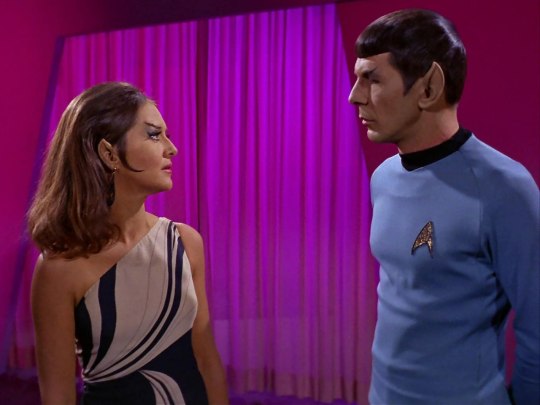
Now, we can only speculate (as if that's not already what I'm doing this whole post lol) about what led the make up habit to be abandoned by the Vulcan men, and that should be the focus of the question since, Romulans and Vulcan women simply kept the ancient tradition intact. What made the Vulcan men stop wearing their eye-shadows and what do they thought of the custom? Would they associate such a trait with their savage era before Surak's? If so, then why Spock proudly wears his make up considering his insecurities regarding his double ancestry? I still have questions, though I have some ideas, but I wrote too much already. Thanks for reading this!

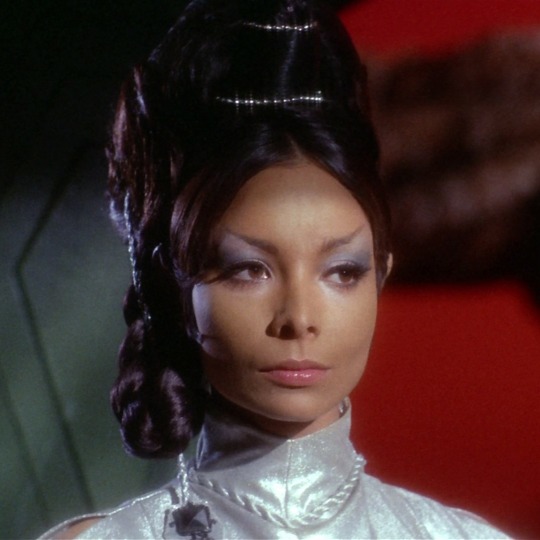
I've noticed that typical Vulcan men do not appear to wear the iconic blue shimmery eyeshadow, while Vulcan women do and with glossy pink lipstick too.



Where as it seems that Romulan men do, in fact, wear eyeshadow. It seems to be an important enough part of their culture that when they put it on Jim too when Bones disguised him as a Romulan.


But you know who also wears eyeshadow (and pink lipstick)? Mister Spock!

Like look! Their makeups literally match. It's very interesting that both Romulan men and women wear makeup, but only Vulcan women seem wear makeup (well maybe the men do too we've just never seen any). And if Romulans and Vulcans have a common ancestor, does it mean that historical Vulcan men did wear makeup? Is Spock doing ancient Vulcan makeup to prove that he's like soooo totally Vulcan? What does it all mean, am I just tin foil hatting 🤔
#i love thinking and writing about these things ><#speculative biology#speculative anthropology#star trek#star trek tos#spock#vulcans#romulans#surak#science#history#text#little essay
735 notes
·
View notes
Text
Reviving Elegance: The Modern Appeal of the Brooch for Men
Introduction
In the ever-evolving landscape of men’s fashion, certain elements once considered outdated are experiencing a dynamic comeback. One such accessory is the brooch for men—a piece of adornment with centuries-old roots that is now gaining ground among contemporary style enthusiasts. While brooches have long been associated with women's wardrobes or royal formalwear, today’s designers and wearers alike are challenging these boundaries, bringing brooches into the everyday fashion conversation for men.
From runways in Milan and Paris to the red carpets of global film festivals, the brooch for men is steadily becoming an emblem of individuality, elegance, and bold style. This resurgence is not just about reviving a lost trend—it's about redefining masculinity and sophistication.
A Brief History of Brooches in Men’s Fashion
The history of brooches stretches back thousands of years. In ancient civilizations like Rome, Greece, and Egypt, brooches were used functionally to fasten cloaks and robes. These items weren’t merely decorative—they denoted status, wealth, and identity. Kings and warriors wore them as emblems of power and allegiance. In medieval Europe, the brooch for men evolved into intricate, gem-studded designs, often bearing family crests or religious symbols.
Even in the 18th and 19th centuries, brooches and pins were common among aristocratic men. These weren’t just ornamental; they often symbolized honor, military rank, or political affiliations. However, as fashion industrialized and became more utilitarian in the 20th century, the brooch faded from everyday men's attire—until now.
Why the Brooch for Men Is Making a Comeback
The modern revival of the brooch for men reflects larger shifts in fashion and cultural expression. Here’s why this trend is resonating:
1. Gender-Fluid Fashion Trends
With gender norms increasingly blurring in the fashion world, more men are exploring accessories traditionally considered feminine. The brooch fits seamlessly into this evolution, offering a way to add flair without compromising masculinity.
2. A Statement of Personal Style
Brooches are no longer limited to formal events. Worn on denim jackets, blazers, kurtas, or even sweaters, a well-chosen brooch serves as a personalized statement piece, often becoming the focal point of an outfit.
3. Influencer and Celebrity Impact
High-profile figures like Harry Styles, Timothée Chalamet, and Ranveer Singh have sported ornate brooches on red carpets, inspiring men around the world to follow suit. Whether it’s a minimalist pin or a dramatic jeweled design, celebrities are showcasing how versatile and powerful this accessory can be.
How to Style a Brooch for Men: From Casual to Couture
Styling a brooch for men is all about understanding balance and intent. Here's how to wear it in different settings:
1. Casual Outfits
Pair a small metallic brooch with a denim or bomber jacket. Look for geometric or quirky motifs that add interest without overwhelming the outfit.
Style Tip: Pin it to the pocket, collar, or even a cap for a subtle flair.
2. Formal or Business Wear
Add a classic brooch to your blazer’s lapel or near the breast pocket. Opt for clean lines, precious stones, or elegant enamel work.
Style Tip: Pair with cufflinks or a tie pin for a cohesive look.
3. Ethnic or Traditional Wear
A brooch for men looks regal on sherwanis, bandhgalas, and kurtas. These pieces often have intricate designs that complement traditional fabrics and embroidery.
Style Tip: Use chains or multi-layered brooches to accentuate the neckline or shoulder.
Materials and Types of Brooches Popular Today
Today’s brooches come in a variety of materials and designs to suit different occasions and personalities:
Metallic Brooches: Sleek and minimal, often made from brass, silver, or gold-plated alloys.
Gemstone Brooches: Embedded with semi-precious stones for an elevated, formal appeal.
Enamel Pins: Colorful and often used to express hobbies, beliefs, or affiliations.
Chain Brooches: Multiple elements connected by chains, ideal for traditional or wedding wear.
Vintage and Antique Styles: Inspired by historical motifs, great for collectors and connoisseurs.
Symbolism and Cultural Significance
In many cultures, a brooch for men is more than a fashion accessory. In India, for instance, a brooch is a vital part of wedding attire, signifying pride and status. In the West, it may represent achievements or affiliations—such as military badges or fraternal organization pins.
Choosing a brooch often involves more than aesthetics; it's about selecting a piece that resonates with your personal story or beliefs. Some wear it to symbolize protection, while others use it to convey power or artistry.
Breaking Stereotypes: The Brooch as a Modern Man’s Weapon of Style
The evolution of the brooch for men is a testament to how fashion can be both cyclical and transformative. What was once reserved for nobility is now accessible to anyone with a flair for self-expression.
Rather than being a novelty or trend, the brooch is carving out a permanent niche in men’s wardrobes. It reflects a broader cultural shift—one where vulnerability, beauty, and individuality are embraced, not concealed. Whether you're wearing a brooch to a wedding, a corporate meeting, or a weekend brunch, it’s a sign that you care about the details—and the story you're telling through your clothes.
How to Choose the Right Brooch
If you're just starting to explore this accessory, here are some tips:
Start Small: Begin with minimalist pins or single-color brooches that blend well with your wardrobe.
Match Your Vibe: Choose designs that align with your existing style—boho, classic, avant-garde, or traditional.
Experiment: Don’t be afraid to try bold pieces for special occasions. Over time, you'll find what works best for your aesthetic.
Pay Attention to Placement: While the lapel is traditional, modern styling welcomes creativity. Try collars, pockets, and even bags.
Conclusion
The brooch for men is more than just a decorative pin—it's a quiet revolution in men’s fashion. It honors tradition while pushing boundaries, offering a canvas for storytelling through design.
As more men reclaim their space in the world of accessories, the brooch emerges as a symbol of confidence, creativity, and connection. Whether you're inspired by history, culture, or contemporary trends, there's a brooch waiting to become part of your identity.
So the next time you suit up, don’t forget to pin on a little personality. It might just be the detail that defines your look.
0 notes
Text
Ethnic wear holds a unique place in the world of fashion. It is a reflection of rich cultural heritage, traditions, and a timeless sense of elegance. The journey of ethnic wear, from its traditional roots to modern fashion statements, is both fascinating and dynamic. Ethnic wear for women, particularly in India, has undergone a remarkable evolution over the centuries, blending traditional fabrics, designs, and cultural motifs with contemporary styles and modern trends. This blog explores the history of ethnic wear, focusing on how it has transformed into a modern-day fashion statement while retaining its cultural significance.
#history of ethnic wear#indian ethnic festive wear#indian ethnic wear#indian ethnic wear for women#indian traditional clothing#indian wear for ladies#kurta pant dupatta set#kurta pant dupatta set online#kurta suit sets for women#kurtis online#ladies dresses online#ladies fashion dress#latest ethnic wear trends#latest fashion dresses#latest kurta pant set with dupatta#new arrival ethnic wear#new designs in ethnic wear#online shopping for ethnic wear#party wear kurti with skirt#party wear kurtis online sale#rich history of ethnic wear#rich history of fashion#role of ethnic wear#salwar kameez online#short suit sets for women#stylish party wear kurti#suit set for ladies#suit sets for women#suit sets online india#suits for ladies
0 notes
Text
Modern Indian Ethnic Wear: Fusion Styles Trending Among Women

Indian fashion is experiencing an exciting evolution. The boundaries between traditional ethnic wear and modern aesthetics are blurring, giving rise to a new wave of fusion fashion that celebrates both heritage and contemporary style. From weddings to workwear, this fusion is redefining the latest fashion for women who want to stay rooted in culture while embracing a global wardrobe.
Let’s explore how modern Indian ethnic wear is being reinvented with fresh silhouettes, unconventional pairings, and contemporary flair—making it one of the hottest trends in women's fashion today.
1. Sarees with a Twist
The saree remains a timeless symbol of elegance, but today’s modern woman is draping it differently. Fusion sarees now feature pre-stitched pleats, dhoti-style draping, or even pant-style sarees. Women are pairing sarees with crop tops, jackets, belts, and sneakers for a chic, street-style edge.
Blouses are also undergoing a makeover. Off-shoulder styles, halter necks, and corset blouses are replacing traditional cuts, giving sarees a fashion-forward identity. These bold reinventions reflect the latest fashion for women who want to look ethnic yet edgy.
2. Indo-Western Kurtas and Dresses
Kurtas are no longer confined to the classic straight-cut design. Now, they come with asymmetrical hemlines, shirt-style collars, and even blazer-style bodices. Designers are blending Western silhouettes like shirt dresses, trench coats, and wrap dresses with Indian fabrics and embroideries to create pieces that can easily transition from daywear to partywear.
Pairing kurtas with jeans, leggings, cigarette pants, or palazzos remains popular, but modern styling includes layering them with shrugs, jackets, and stoles for a more dynamic look.
3. Lehenga Sets with Contemporary Elements
Lehengas are no longer just wedding wear—they are now seen at brunches, festive gatherings, and even formal events. The latest fashion for women showcases lehengas styled with crop tops, denim jackets, and capes instead of traditional cholis. High-low hemlines, mix-and-match separates, and minimalist embroidery are key elements of this trend.
Lightweight fabrics such as georgette, crepe, and tulle are preferred for casual elegance, while bold prints and metallic tones make fusion lehengas stand out at evening functions.
4. Tunic Tops and Dhoti Pants
Another fusion trend gaining traction is the pairing of tunic-style tops with dhoti or tulip pants. This look is comfortable, stylish, and ideal for semi-formal or festive occasions. Tunics with Indo-boho prints, mirror work, or subtle zari add just the right ethnic touch.
This silhouette flatters all body types and is often accessorized with statement jewelry and embellished footwear to complete the Indo-fusion vibe.
5. Jumpsuits with Ethnic Accents
For the fashion-forward crowd, jumpsuits infused with Indian textiles or embroidery offer a bold yet elegant fusion option. You’ll find jumpsuits made from Banarasi silk, Ikat, or block-printed cotton paired with ethnic belts or dupattas.
This is an ideal choice for those seeking one-piece outfits that are stylish, versatile, and rooted in Indian aesthetics.
6. Fusion Accessories and Footwear
Fusion fashion isn’t just about clothing. Accessories play a vital role in elevating the look. Statement silver jhumkas paired with off-shoulder dresses, embroidered juttis worn with jeans, or potli bags replacing clutches—these combinations blend tradition and trend seamlessly.
Even beauty trends are in sync with fusion fashion. Think bold kohl eyes with nude lips or gajra-adorned buns with tailored suits—perfectly marrying the old with the new.
Final Thoughts
Fusion ethnic wear represents a cultural shift where tradition and modernity coexist in harmony. For today’s women, fashion is not just about following trends—it's about expressing identity, versatility, and individuality. The rise of fusion ethnic wear clearly reflects the latest fashion for women, blending Indian elegance with global flair.
Whether it’s a saree styled with a leather belt or a lehenga worn with sneakers, modern ethnic fashion is here to stay. Embrace the blend, break the rules, and redefine tradition with your own style twist.
0 notes
Text
The Return of the Sharara Fashion’s Favorite Ethnic Comeback
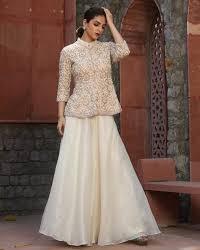
The Return of the Sharara: Fashion’s Favorite Ethnic Comeback
Once a staple in royal wardrobes during the Mughal era, the Sharara has made a powerful return to the contemporary ethnic fashion scene. With its signature flared bottoms, graceful kurta pairings, and timeless elegance, the Sharara is no longer just a nostalgic nod to tradition — it's fashion's favorite ethnic comeback, and it’s here to stay.
From celebrity wardrobes to festive collections on the runway, the Sharara is being reimagined in bold, beautiful, and modern ways. Here's a look at how and why the Sharara is reclaiming its place in the spotlight.
👑 1. A Royal Heritage Reborn
The Sharara originated in the regal courts of Awadh and was once worn by queens and noblewomen. Characterized by its heavily flared trousers paired with a short or long kurta and dupatta, the outfit oozed luxury and sophistication.
Now, with a modern twist, the same silhouette is turning heads at weddings, sangeets, and festive gatherings. Today’s Sharara combines traditional craftsmanship with contemporary cuts, making it the perfect fusion outfit for the modern Indian woman.
👗 2. Design Evolution: From Classic to Contemporary
Designers are breathing new life into the Sharara with innovative fabrics, structured tailoring, and creative embellishments. What once was a heavily embroidered wedding staple has evolved into a versatile look that can be styled for daytime functions, cocktail nights, or even casual wear.
Some popular reinterpretations include:
Cape-style Shararas with crop tops
Peplum kurtas paired with lightweight flared bottoms
Layered and tiered shararas that add dramatic movement
Belted dupatta looks for a sleek, defined waistline
🎨 3. A Color Palette for Every Personality
Gone are the days when Sharara sets only came in traditional reds and maroons. Today, the color story is more inclusive and expressive. Brides are opting for pastels, muted golds, emerald greens, and even ivory and greys for pre-wedding functions.
Bold colors like fuchsia, teal, and mustard are also trending among wedding guests, making the Sharara a favorite across age groups and occasions.
🧵 4. Artisan Embellishments Meet Minimalism
From rich zardozi and chikankari embroidery to subtle gota patti and mirror work, Sharara sets now cater to both maximalist and minimalist sensibilities. Lightweight, breathable versions with delicate detailing are perfect for summer festivities, while opulent, handworked sets remain go-to choices for weddings and receptions.
This flexibility allows the Sharara to move effortlessly from daywear to evening glam.
👠 5. Why Everyone’s Wearing It — Celebrities Included
Whether it's Alia Bhatt's pastel sharara set at a Diwali party or Kareena Kapoor Khan’s opulent wedding look, Bollywood is playing a major role in the Sharara’s revival. Their off-duty glam meets traditional elegance look has redefined the outfit as something both high-fashion and deeply rooted in Indian culture.
Add to that its comfort factor and flattering shape — and you’ve got a look that works for all body types, moods, and moments.
✨ Final Verdict: A Classic Made Modern
The return of the Sharara isn’t just a trend — it’s a cultural renaissance. It celebrates the richness of Indian heritage while embracing the bold individuality of today’s fashion landscape. Whether you love all things vintage or prefer your ethnic wear with a dash of modern drama, there’s a Sharara out there with your name on it.
Find latest design for sharara you can check our Full Blog
0 notes
Text
Kurta Pajama Design: Where Heritage Meets Contemporary Style
In the world of men’s ethnic fashion, few outfits are as iconic, elegant, and enduring as the kurta pyjama for men. This traditional attire has transcended generations and borders, evolving from a simple daily wear garment to a versatile outfit suited for weddings, festivals, and even casual outings. With the rise of modern tailoring and fashion-forward thinking, the kurta pajama design has taken on exciting new dimensions—blending tradition with trend.
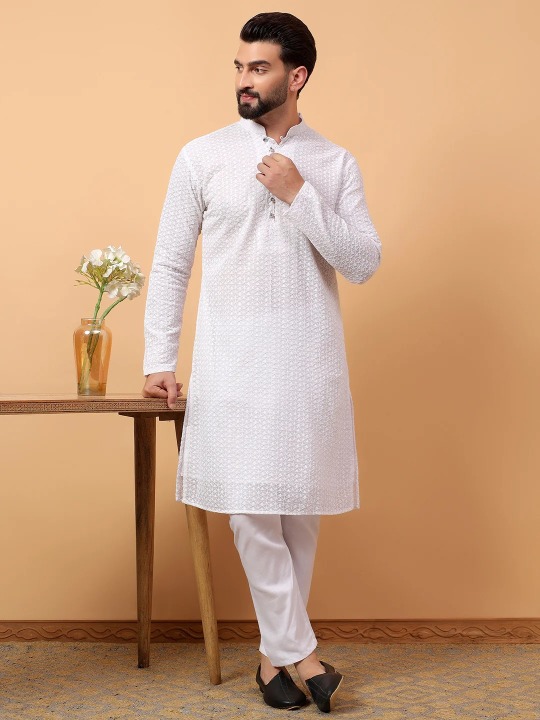
Whether you're looking for a timeless white kurta pajama for men or exploring new-age styles paired with designer jackets, the kurta pajama remains an irreplaceable part of Indian menswear. And with the growing popularity of affordable fashion, men now have access to Luxury at Less—style and quality without the steep price tag.
The Legacy of Kurta Pajama
The kurta pajama has long been a symbol of South Asian identity. Traditionally made from breathable cotton or khadi, it was worn for comfort and modesty in daily life. But what makes this outfit so remarkable is its ability to adapt to different eras, evolving in silhouette, fabric, and design while maintaining its core cultural roots.
Today, the mens kurta pajama is not just a traditional outfit—it’s a statement of pride, elegance, and individuality.
Modern Kurta Pajama Designs: A Style for Every Man
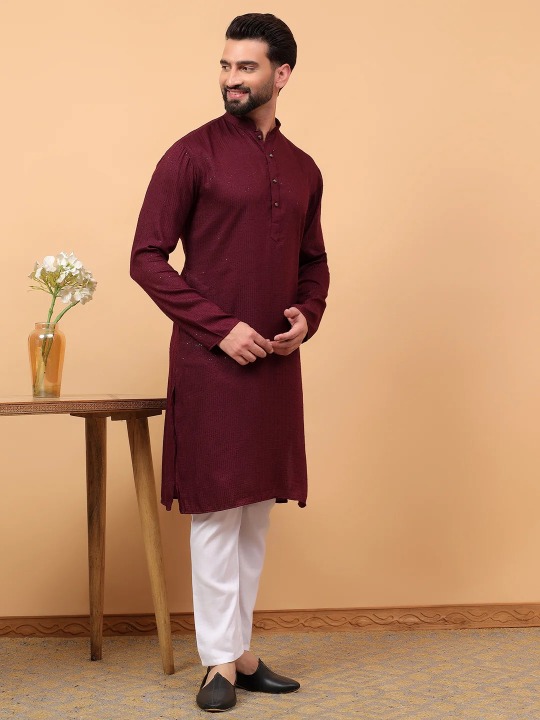
As designers continue to innovate, the kurta pajama design has become more diverse and dynamic. Here are the key styles shaping the modern wardrobe:
1. Minimalist Cotton Kurta Pajamas
Ideal for everyday wear or intimate gatherings, minimalist cotton kurtas offer a clean and breathable option. Straight cuts, subtle buttons, and pastel shades dominate this style, making it perfect for summer days, poojas, or even casual Fridays at the office.
2. Designer and Embroidered Kurta Pajamas
For grand occasions, men turn to designer kurtas made from silk, brocade, or jacquard fabrics. These kurtas often feature hand embroidery, mirror work, or digital prints—adding texture and richness. Matched with churidars or straight-cut pajamas, these outfits are made for celebrations.
3. Fusion-Inspired Kurtas
Breaking the mold, fusion kurtas introduce asymmetrical cuts, draped panels, high-low hems, and side-slit designs. These pair well with dhoti pants, trousers, or tapered pajamas, offering a more global appeal to the kurta pyjama for men.

Timeless and Elegant: White Kurta Pajama for Men
Nothing captures effortless class like a white kurta pajama for men. The purity and simplicity of white allow it to shine in a variety of settings—be it religious functions, Independence Day events, or daytime weddings.
You can keep it minimal or style it up with colorful stoles, ornate footwear, or even a bold jacket with kurta pajama. The white kurta serves as the perfect base to build any look, traditional or modern.
Leveling Up: Jacket with Kurta Pajama
One of the most stylish evolutions in menswear is the addition of a jacket with kurta pajama. It brings a structured, layered look that’s ideal for formal events. Here’s a look at some popular jacket styles:
Nehru Jackets
Short, collarless, and structured, the Nehru jacket is a timeless pairing with kurtas. Available in rich fabrics like raw silk and velvet, it can instantly enhance even the simplest kurta.
Bandhgala Jackets
For a more regal look, Bandhgala jackets add full coverage with a closed-neck design. They’re ideal for weddings or evening receptions, exuding elegance and sophistication.

Modern Short Jackets
Tailored jackets with asymmetrical cuts, digital prints, or metallic finishes are trending among younger men. These pair especially well with solid-color kurtas or white kurta pajama for men for contrast and impact.
Choosing the Right Fabric
Fabric plays a major role in the look, feel, and functionality of your mens kurta pajama. Here are some popular options based on occasion:
Cotton: Lightweight and breathable; ideal for casual and summer wear.
Linen: Smooth and upscale; great for semi-formal events.
Silk & Brocade: Rich and festive; perfect for weddings and formal functions.
Velvet: Typically used in jackets; adds opulence to evening wear.
Footwear & Accessories to Match
Your look isn't complete without the right finishing touches. Pair your kurta pajama with traditional mojaris, Kolhapuris, or even stylish loafers for a modern twist. Accessorize with a classy watch, minimal jewelry, or a pocket square in your jacket.
Luxury at Less: Style Within Reach
What was once considered luxury—hand-embroidered kurtas, silk fabrics, or designer cuts—is now available at accessible price points. Thanks to the Luxury at Less trend, more men can afford to look and feel great without overspending.

From boutique brands to online marketplaces, the options for premium-quality kurta pyjama for men have grown significantly. Whether it’s a custom-tailored outfit or a ready-to-wear piece, value-focused fashion is making ethnic wear more inclusive than ever.
Final Thoughts
The kurta pajama continues to evolve as one of the most iconic outfits in men’s fashion. With its roots in tradition and eyes on the future, it has adapted to reflect the personality and preferences of today’s man. From understated white kurta pajama for men looks to rich embroidered ensembles topped with a statement jacket with kurta pajama, this attire is as versatile as it is stylish.
And with the rise of Luxury at Less, you don’t need to compromise between quality and cost. No matter your style—minimal, regal, or experimental—there’s a kurta pajama design waiting to help you make your mark.
0 notes